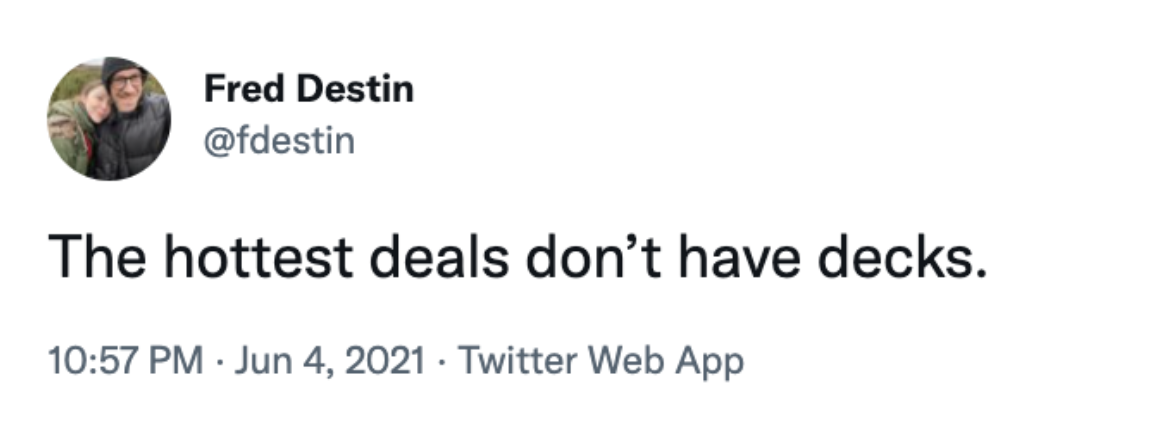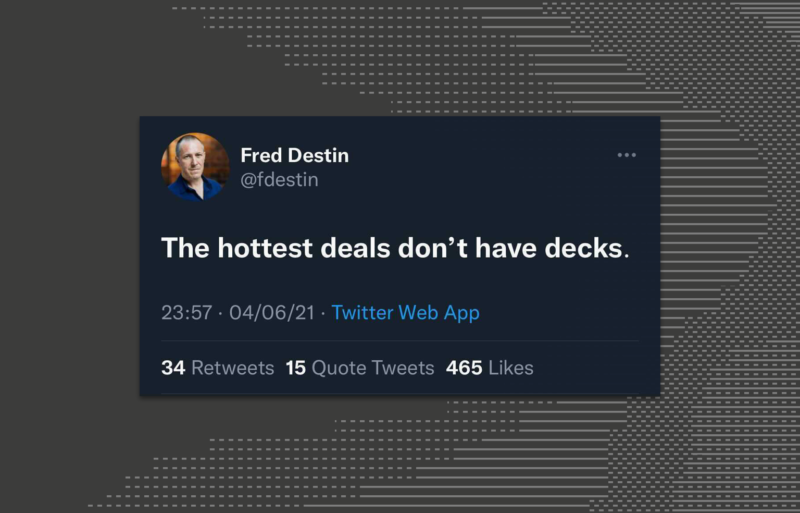This can be highly controversial and many founders simply won’t manage to do it. I do still think preparing to pitch without slides can be an interesting exercise. If you manage, it works like magic, but be aware it’s not for everyone – and that’s okay. There’s plenty of other strategies you can learn in order to lead your funding round.
Die, pitch, die!
There, I said it. Kill it.
Over, done, never again.
I’ve never been a big fan of the word “pitching”. It implies that something isn’t really true, that some of it is fake or concealed, or made up, some kind of repetitive sales job – and also that it’s scripted. Which implies acting, rehearsed, fake, not real life. I don’t like it.
I know I’m not alone with this view. Most people (and certainly most investors) dislike it too; nobody enjoys being “pitched to” or have to review endless “pitch decks” or suffer boring, scripted investor pitches in “pitch mode”. Personally, I think that era deserves being sent off to pasture – we’ll all be better for it. Long live the more honest and interesting narrative, storyline and conversations.
How investors wish to invest
VCs (and others) invest in people first, especially at early stage – in truth they have little else to go by. They typically go after the founder with the passion, the smarts and the insatiable determination to solve a specific problem, ideally with an A-star team around them.
Then, beyond the logic, financials and data, investors back people they LIKE (kind of obvious, really, why waste 7-10 years building a business with somebody you dislike?!), and that needs time, trust, and a personal connection.
Finally, investors look for the new-new thing, the never-thought-of invention, or the maverick go-against-the-grain dissident, the next big thing. Outliers, misfits, creators, creative, geniuses… you know the tags they love to use. Different is just not cool, it’s now mandatory – investors seek outliers, not copycats (well, some do, but that’s another topic altogether!).
Pitch templates
And yet, what do most founders typically do? They go for a template, a “blueprint”, typically the best seller (translate: biggest number of copies in circulation). Where’s the outlier, innovator or rebel in that? All that passion, driven stubbornness, that excitement… they never come out on templated slides (especially with tech founders who, let’s face it, aren’t exactly Hollywood actors).
So you lose the excitement, and you lose the person investing. It’s as simple as that.
I could recommend the “by all means you can have a deck, but then build your own story, your own path, your own style, your own differentiator”.
But I won’t – today I’ll argue for you NOT to build any deck at all.
Yep, you read that right: no slides, no pitch. None. Zilch, nada. Not one. Yes, I mean it. I want you to think about pitching without slides. And the best part is, it works like magic. It makes you really stand out from the crowd, gives investors ALL of the information they need, with none of the boring parts, and builds something decks can’t get you: trust.
Wanna know how to achieve that?
Choose pitching without slides and focus on having a meaningful, natural, two-way conversation
Instead of preparing scripts and PowerPoint slides, prepare for a conversation.
Why?
Because a good conversation is 10x more effective than a scripted pitch. A good, well-planned and structured conversation has many benefits.
For starters, it has its own flow, timing, errands and digressions, never twice the same. It’s also a great way to easily spot what your prospect investor likes or not, believes or not, knows well or not, finds exciting or not. My favourite of all: it gives you the chance to ask your own questions, which you can’t do when pitching. Ask about her, how she sees a point you just made, what she likes about it, what she’s seen elsewhere. It’s the real, instant, natural feedback spoken freely and in real-time, not days after your pitch.
Good conversations carry logic, questions and answers, arguments and counter-arguments, admissions and changes of opinion, none of which you can get in a scripted pitch. And that weird and wonderful sequence is what builds trust between people.
Trust is gold in fundraising.
Finally and boy oh boy do they loooove data – they crave it. So be generous with it, they’ll love you for it – don’t be smug or lecture anybody, just share pertinent bits as you develop a point, use it to support your claims; don’t swamp, just drop some numbers and move on casually to the next point. We wrote a whole article on this the other day.
What you must have when pitching without slides?
It is obvious, but it’s not easy. It requires IQ, EQ, and a ton of effort. Let’s delve in.
Hard facts to support your claims (IQ)
Like with any good conversation, If you don’t have the hard facts to support your claims your conversation will end rather quickly. Leave a couple of important questions open, with no satisfactory reply, and investor trust will plummet.
Rule number 1: know your stuff or don’t do it – you only get one shot at this.
(it reminds me of the “coffee chats, not a pitch” meetings that nearly always end up in disaster, with the founder in tatters and never invited to meet again. As we said before, there are no coffee chats, folks… if the investor leaves the meeting thinking “no thanks” or even “meeeh, not that special”, you’re done.)
So you’d better come equipped with those compulsory data points especially when you’re pitching without slides.
Market size, competitive landscape, all financials. Other important questions you must answer are why now, why you, team CV takeaways and so on and so forth. Naturally, you obviously MUST know your numbers.
You will be judged based on the “minimum knowledge” a CEO must possess, so come armed with it.
Emotional Quotient (EQ)
This is one of the reasons why those casual chats usually take place with more seasoned entrepreneurs.
To think about pitching without slides, you’ll need to have a good grasp of people; read the investor’s mind and body language, what intrigues her, what she finds exciting or positive, or unconventional wisdom, and read those “oh, never thought of that” moments. You need to be good enough with people.
You’ll need to convey points firmly but calmly when challenged, and move the conversation on to the points you want to make, sometimes against the investor’s will. You’ll have to develop a relationship, showing strengths and certainty but also admit weaknesses and doubt.
It takes years to get to this level of comfort for most founders, and some simply can’t stop faking it “til you make it”.
Remember: you’re not here to lecture or show off, you’re here to show that you have discovered a great “white space” in the market (and/or have started building it and it’s starting to look good across your KPIs), have a healthy mix of confidence, proof points, data and knowledge, and trustworthiness.
This EQ thing is harder.
But that quietly powerful, confident delivery and trust-building conversations… it’s worth GOLD.
That’s when the tables turn and you get investors lining up.
Something I learned from experience? Avoid more than one person in the room. There’s always going to be one a&&hole trying to show off IQ or academic skills in front of the boss, taking away the conversation from where you’re trying to lead it – extremely disruptive and 100% no value-add most times.
Effort and Practice
Unlike EQ skills, effort and practice are available and mandatory for all. You’re going to need to learn a lot of data – a lot –, from numbers to markets to people’s names to historical and competitive facts, and be able to make use of them elegantly during a conversation.
You will also need to drive the conversation towards your strong points and field questions you haven’t prepared for. All of this while you need to ensure that all usual categories of questions are covered – even if they are not asked (investors have this mental checklist they go through, so don’t wait to be asked, just tell them).

If you’re having trouble putting this together, join our next Bootcamp and get funded efficiently.
That’s what we do 😉
